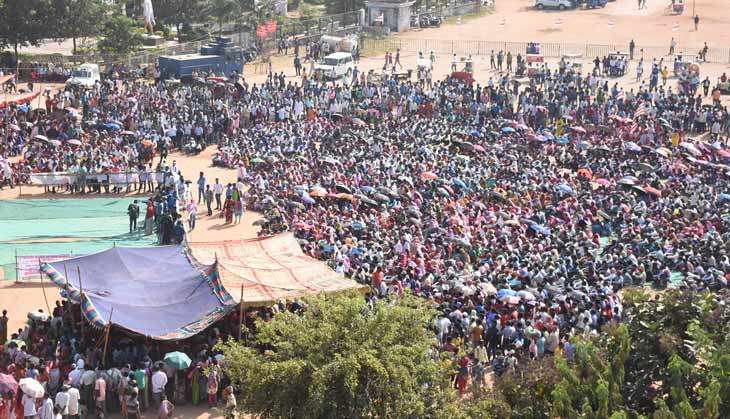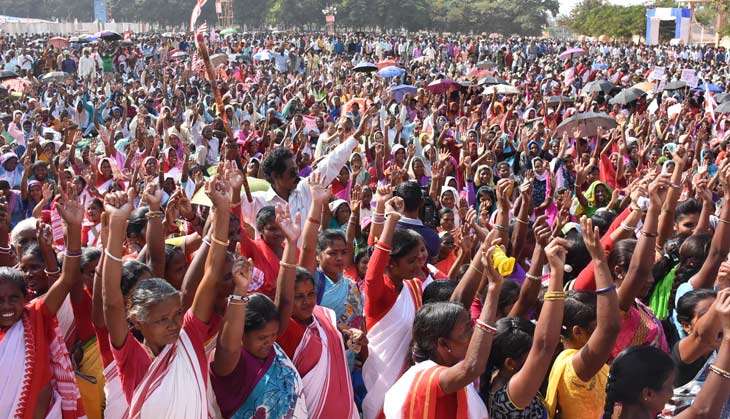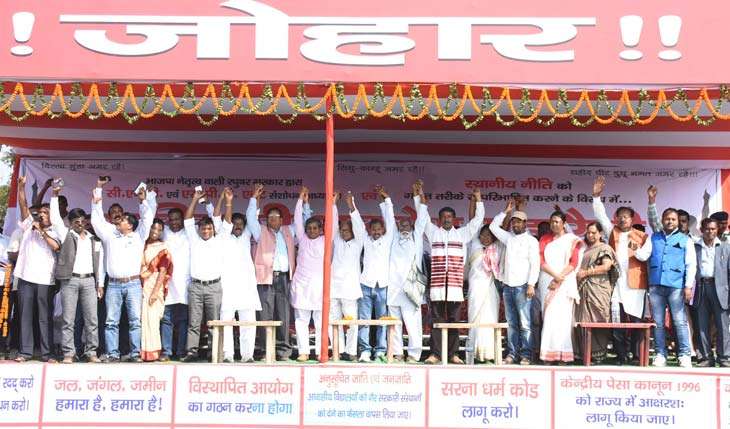3 police firings, 7 deaths: Is Jharkhand govt at war with tribals?

Jharkhand has been in turmoil for the past three days. The controversy over the killing of an Adivasi activist in police firing during 'Adivasi Aakrosh' rally in Ranchi on 22 October has taken the state by storm.
Parallel rallies
The rally was jointly organised by 42 tribal organisations. Thousands of Adivasis from across Jharkhand had thronged the streets of Ranchi for the event. The Raghubar Das BJP government had drawn a strategy to prevent the rally from being a success. It called for a parallel 'Gramin Vikas Sammelan' on the same day to divert attention from the Adivasi Aakrosh rally.
As it is, Adivasi leaders had been warning the government against the proposed amendments in the Chotanagpur Tenancy Act and Santhal Pargana Tenancy Act (CNT and SPT Acts) as well as the alleged discrimination against tribals in the controversial domicile policy. But instead of addressing these issues, CM Raghubar Das decided to extol the achievements of his government at the HEC ground, in Ranchi.
Also read - Communal politics taking root in Jharkhand. These incidents prove it
Das showered major announcements from the stage at this venue including promising land to two lakh tribals, jobs to 70,000 Adivasi families, beautification of tribal sanctuaries and honorarium to chieftains running the traditional administrative system of the native communities.
Just a day before the tribal congregation, the chief minister's media managers had also roped in several intellectuals to write advertorials in major local newspaper editions praising the government's policies. However, this branding fell flat on its face due to some of the other happenings during the day.
Police action

One person was killed and scores of others injured as the police fired upon the angry mob at the Soyko Bazar in Murhu, situated 50 km from Ranchi. The crowd was reportedly going to take part in the 'Aakrosh' rally in the capital.
This came as an embarrassment to the Das government that is already facing flak for the recent police action in Gola and Barkagaon. The police high-handedness in earlier cases was against locals who were protesting industrial projects.
But this time the state has unleashed its might against the tribals who were a part of the statewide demonstration for their rights. There are speculations that the government might be bracing itself for a larger backlash.
The flashpoint

The Murhu region comes in Khunti district is considered a stronghold of radical Left organisations like the People's Liberation Front of India (PLFI). There are fears that these outfits might use the firing incident to mobilise local villagers for further trouble.
Various accounts have emerged over the Soyko Bazar firing. The locals allege they were marching towards Ranchi on foot as vehicles were not available. According to them, the police halted the march and started a baton charge without any provocation. Soon, the situation turned for the worse and the cops opened fire resulting in the killing of a local tribal named Abraham Munda. Over half-a-dozen others were injured.
Claims and counter claims
The police sources contest this claim.
"We were passing through the Soyko Bazar, when we saw that the agitators were forcibly evicting a tourist bus. We tried to intervene, but the protestors held us hostage. The police station in charge was among the officials detained. Later, they also clashed with the DSP," says ASP Anurag Raj, who was among the police personnel allegedly intimidated by the crowd. He has also sustained injuries in the violence.
DSP Anand Lagori recounts, "On reaching Soyko Bazar, I saw many police persons were being held hostage. The mob was also misbehaving with the bus passengers. I tried to pacify the agitators through talks. However, I was assaulted with hockey sticks and iron rods. Fortunately, they failed to snatch my weapon. Otherwise, the situation would have been much worse. Those were not innocent protestors, but armed people."
IG MS Bhatia, the spokesperson of the Jharkhand police, has also defended the police action. Claiming that the cops had to open fire in self-defence, Bhatia stated, "There were over 1,000-1,500 people in the mob. Many of them were people belonging to extremist organisations like PLFI."
The tensions are soaring in the area amid these claims and counter claims. On 23 October, Sunday, hundreds of local villagers were out on the streets in Khunti with traditional weapons. They encircled the residences of several government officials. Similar scenes were witnessed on Monday during the bandh called by the Adivasi groups.
Govt silent
The government has so far maintained a studied silence over the Soyko Bazar violence. It is trying to brave out the controversy by announcing a probe, doling out compensations and passing the buck to the Naxals.
However, the government may find it difficult to wash its hands off the situation so easily, considering that it was third incident of police firing in the state within the last 55 days.
"The Jharkhand government is trying to emulate the development model of the Chhattisgarh state. It is increasingly targeting the Adivasi resistance. One can clearly see a lot of blood being spilled in the near future," fears Ashwini Kumar Pankaj, an expert on Adivasi issues in the state.
A warning signal

The impact of the 'Adivasi Akrosh' rally on 22 October is likely to reverberate in the state politics for some time, even if one were to ignore the firing incident. It was not a political event. Yet, thousands of tribals from all parts of the state attended the rally.
The former Chief Minister Babulal Marandi, his party colleague Bandhu Tirki, senior Congress leader Dev Kumar Dhan, the former Congress state president Pradeep Balmuchu, the Maoist-turned-JMM leader Poulus Surin and several prominent Adivasi activists and intellectuals marked their presence in the rally.
Babulal Marandi says the rally was a warning signal for the state government. In tribal activist Dayamani Barla's opinion, the government is branding any person fighting for tribal rights as a Naxal.
The impact of the 'Adivasi Akrosh' rally on 22 October is likely to reverberate in the state politics for some time, even if one were to ignore the firing incident. It was not a political event. Yet, thousands of tribals from all parts of the state attended the rally.
The former Chief Minister Babulal Marandi, his party colleague Bandhu Tirki, senior Congress leader Dev Kumar Dhan, the former Congress state president Pradeep Balmuchu, the Maoist-turned-JMM leader Poulus Surin and several prominent Adivasi activists and intellectuals marked their presence in the rally.
Babulal Marandi says the rally was a warning signal for the state government. In tribal activist Dayamani Barla's opinion, the government is branding any person fighting for tribal rights as a Naxal.
Factionalism?
The chief minister, on his part, alleges that some people were using the issue of CNT and SPT Acts to derail the process of development in the state. He insists that the government is not going to change the basic structure of these Acts and it only wants to simplify some of its provisions.
This explanation has not cut much ice even within the chief minister's own party. The schism along the lines of tribal and non-tribals is also polarising the BJP. There are rumours that the 22 October rally had the tacit backing of the BJP leader Gangotri Kujur. She had reportedly taken an active part in the preparations for the rally and found the support of several tribals leaders of her party. All the efforts to talk to Gangotri Kujur on the issue proved futile.
Nevertheless, sources confirm that the tribal lobby within the BJP is preparing the ground to oppose Raghubar Das for a long time. The Chief Minister's domicile policy was a product of the pressure from inside his party, more than the demand of the opposition.
Edited by Aleesha Matharu
More in Catch - Hazaribagh killings: has Jharkhand police become a tool of the coal mafia?
Minor marriage controversy: will Jharkhand state BJP chief's head roll?
First published: 24 October 2016, 11:07 IST




![BJP's Kapil Mishra recreates Shankar Mahadevan’s ‘Breathless’ song to highlight Delhi pollution [WATCH] BJP's Kapil Mishra recreates Shankar Mahadevan’s ‘Breathless’ song to highlight Delhi pollution [WATCH]](https://images.catchnews.com/upload/2022/11/03/kapil-mishra_240884_300x172.png)

![Anupam Kher shares pictures of his toned body on 67th birthday [MUST SEE] Anupam Kher shares pictures of his toned body on 67th birthday [MUST SEE]](https://images.catchnews.com/upload/2022/03/07/Anupam_kher_231145_300x172.jpg)






